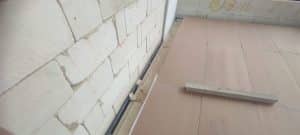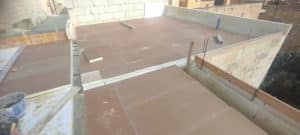Let’s be honest—ripping up old tiles is dusty, time-consuming, and expensive. If you’ve ever dreamed of upgrading your floors or walls without the chaos of demolition, you’re not alone. One of the most common questions we hear is: can you microcement over tiles?
And the good news? Yes, you absolutely can.
In fact, this is one of the key reasons why microcement is such a popular renovation choice across Malta. Whether you’re updating a dated bathroom, a tired kitchen backsplash, or even outdoor tiles on a terrace, microcement can be applied directly over the existing tiles—saving time, money, and mess.
In this post, we’ll break down five compelling reasons why microcement over tiles makes so much sense, how it’s done, and why it could be the right move for your next project.
1. Skip Demolition and Save Time| Can You Microcement Over Tiles
Tearing up tiles can be a nightmare—loud, dusty, expensive, and full of surprises (like damaged substrates). One of the biggest benefits of microcement is that it can go right over your current tiles without removing them. That means:
No noise or mess from chiseling
No need to dispose of heavy construction waste
No risk of damaging the surface underneath
No waiting for days while the area is cleaned and prepped
Instead, microcement is applied in ultra-thin layers (typically just 2–3 mm thick) over the existing tiles. A bonding primer ensures excellent adhesion, followed by reinforcing mesh and several coats of microcement. The result? A sleek, modern surface that feels like a total transformation—without demolition.
It’s a massive time-saver. A typical bathroom renovation that might take 2–3 weeks with full tile removal can often be finished in just 4–7 days using microcement.
2. Versatile Application for Walls, Floors, and More | Can You Microcement Over Tiles
You might be wondering: “Sure, you can microcement over tiles, but will it hold up on floors? What about vertical surfaces?”
Here’s the beauty of microcement: it adheres to both horizontal and vertical surfaces with ease. That means you can use it in:
Bathrooms (walls, floors, even inside showers)
Kitchens (backsplashes, countertops, floors)
Living rooms and staircases
Commercial spaces
Outdoor terraces and facades (yes, even over exterior tiles)
It’s especially valuable in apartments or heritage properties in Malta where demolition is impractical or restricted. And unlike laminate or vinyl, which can bubble or lift, microcement becomes one with the surface, offering unbeatable durability.
So yes—can you microcement over tiles on any surface? The answer is still a confident yes.
3. Seamless, Waterproof, and Modern Finish | Can You Microcement Over Tiles
Let’s face it—old tiles, no matter how clean, often look dated due to grout lines, discoloration, or cracks. Microcement eliminates all that by creating a smooth, seamless finish that’s both stylish and practical.
When sealed properly, microcement is:
100% waterproof
Resistant to stains, scratches, and impacts
Non-slip (when textured)
Available in dozens of modern shades and textures
You can go matte, satin, or even glossy—whatever suits your interior style. Want an industrial concrete look? Or maybe a warm beige to mimic natural stone? All possible.
And because it’s applied by hand, every surface has a unique artisan touch. Perfect for homeowners in Malta looking to create a bespoke, high-end look without the construction drama.
4. Cost-Effective Compared to Full Renovation | Can You Microcement Over Tiles
Price matters, especially when you’re weighing a full renovation versus a surface makeover. One of the best things about microcement is that you get a luxury finish without a luxury budget—especially when you skip demolition.
Let’s look at some rough figures for the Maltese market:
| Renovation Type | Estimated Cost (€/m²) |
|---|---|
| Traditional tile removal + new tiles | €80–€150 |
| Microcement over existing tiles | From €65 |
These prices include materials and professional labor. The cost savings really add up when you factor in the reduced timeline, fewer tradespeople, and no debris disposal fees.
So, can you microcement over tiles and save money? Without question.
5. Eco-Friendly and Less Wasteful | Can You Microcement Over Tiles
Microcement isn’t just a practical or aesthetic choice—it’s also an environmentally responsible one. Traditional renovations often involve:
Removing and discarding old tiles
Replacing with new tiles (and all the waste that entails)
Heavy dust and rubble, which require disposal
With microcement, you reuse the existing substrate and build on top of it. There’s no need to send anything to the landfill. Plus, most modern microcement products use low-VOC or water-based formulas, making them safe for your home and the planet.
It’s a win-win: stylish upgrades with a reduced environmental impact.
But Wait—Will It Last? | Can You Microcement Over Tiles
Some people worry: if I apply microcement over tiles, will it crack or peel?
Not if it’s applied correctly.
Microcement is incredibly strong thanks to flexible resins, fiber-reinforced layers, and a protective sealer. When tiles are properly cleaned, primed, and stabilized, the new surface becomes bonded and highly resistant to cracks or damage.
The key is professional application. An expert will:
Identify and fix any hollow tiles
Fill joints to ensure a smooth base
Apply a bonding primer suited for ceramic or porcelain
Use mesh reinforcement for durability
Seal everything with a waterproof, UV-resistant topcoat
With proper care, a microcement finish can last 10–15 years or more, even on high-traffic floors.
Ideal Projects in Malta for Microcement Over Tiles | Can You Microcement Over Tiles
In Malta, where many buildings feature ceramic or stone tiling from the early 2000s or older, microcement over tiles offers a fresh, modern alternative without expensive gut jobs. Here are just a few ideas:
Bathrooms in Sliema apartments: No need to disturb neighbors or deal with old plumbing.
Kitchens in heritage Valletta homes: Keep the structure intact while upgrading aesthetics.
Terraces in coastal villas: Apply a waterproof finish that resists salt and sun.
Commercial interiors in St. Julian’s: Fast turnaround with a clean, professional look.
Not sure if your surface is suitable? Contact Kibitec—we’re happy to assess your tiles and suggest the right system.
Construction-Approved Methodology | Can You Microcement Over Tiles
Microcement application over tiles isn’t a shortcut—it’s a well-established process used in professional construction and renovation projects across Europe. It requires technical knowledge and a multi-step system to ensure strength, adhesion, and waterproofing.
Learn more about the building science behind this material by checking out this construction article on Wikipedia.
At Kibitec, we follow industry best practices to ensure your new surface is beautiful, durable, and long-lasting—especially in Malta’s humid and sun-drenched conditions.
FAQs About Microcement Over Tiles | Can You Microcement Over Tiles
Even with all the benefits, it’s normal to have a few questions. Let’s address the most common concerns Maltese homeowners have when considering this type of renovation.
Will the tile joints show through?
No—the grout lines won’t be visible once the microcement is applied properly. Before anything is added, the surface is leveled with a base coat or filler to smooth out the joints between tiles. Once the base is flat and solid, the microcement layers go on top, creating a uniform surface.
Can it be used on cracked or loose tiles?
Here’s the honest answer: not directly. If the existing tiles are cracked, hollow, or loose, they’ll need to be stabilized first. This might mean:
Replacing individual tiles
Filling in gaps or cracks
Securing the base to avoid movement
The goal is a solid, unmoving foundation. Once that’s done, microcement can be applied confidently and will last years without cracking.
Is it resistant to heat and humidity?
Yes! Microcement is ideal for:
Kitchens – It handles high temperatures around stoves or ovens
Bathrooms – It’s waterproof, mold-resistant, and holds up to humidity
Outdoors – When properly sealed, it resists UV rays and the Maltese sun
Microcement doesn’t expand or contract like other materials, so you won’t see warping or bubbling.
Can it be applied on wall tiles too?
Absolutely. Microcement over vertical tiles is a common solution in Malta, especially in bathrooms, stairwells, or kitchen walls. With skilled hands, the finish looks sleek and continuous—like polished concrete or stone.
Real Renovation Stories from Malta
A Modern Bathroom Makeover in Mosta
“We were stuck with beige wall tiles from the 90s. Removing them would’ve ruined the plasterboard and delayed everything. Kibitec suggested microcement instead. In just five days, we had a seamless, modern bathroom in a soft grey tone that matched our new vanity. Zero mess, and no need to retile. Couldn’t be happier!”
— Claudia M., Mosta
Coastal Kitchen in Mellieħa
“The salt air had worn out our old kitchen tiles. We wanted something durable but modern. Kibitec’s team applied microcement over the tiled backsplash and floor. It completely changed the look and feels so much easier to clean. Plus, no demolition!”
— George & Lia, Mellieħa
Pros and Cons: Microcement Over Tiles
Every material has its pros and cons. Here’s a quick breakdown to help you decide if this is the right choice for your space.
| Pros | Cons |
|---|---|
| ✅ No demolition needed | 🔧 Requires expert application |
| ✅ Saves time and labour | 📏 May raise floor height slightly (2–3 mm) |
| ✅ Seamless, modern finish | ⏳ Needs curing time before use |
| ✅ Waterproof and easy to clean | 💧 Requires proper sealing for wet zones |
| ✅ Can be used indoors and outdoors | 🧽 Needs occasional resealing (every 3–5 years) |
Overall, the pros heavily outweigh the cons—especially if you’re working with a trusted team that uses top-grade materials and applies each layer with precision.
Final Verdict: So, Can You Microcement Over Tiles?
Yes—microcement is not only compatible with tiled surfaces, it’s often the smartest way to renovate. Whether you’re looking to modernise a bathroom, refinish a kitchen, or give your terrace a sleek new look, applying microcement over tiles is fast, cost-effective, and eco-friendly.
You avoid demolition. You save time and money. And you get a waterproof, seamless finish that instantly modernises your space.
With microcement starting from around €65/m², it’s a serious alternative to traditional renovation in Malta.
Ready to Upgrade Your Space Without Demolition?
At Kibitec, we specialise in professional microcement application over tiles throughout Malta. Whether it’s a residential project in Sliema, a seaside villa in St. Paul’s Bay, or a commercial renovation in Valletta, our team delivers smooth, stunning results.
✔️ Site inspection
✔️ Honest advice
✔️ High-quality materials
✔️ Local experts
Let’s talk about your project. Contact us today at 👉 https://kibitec.com/contact-us/
Let your renovation begin—without picking up a hammer.




